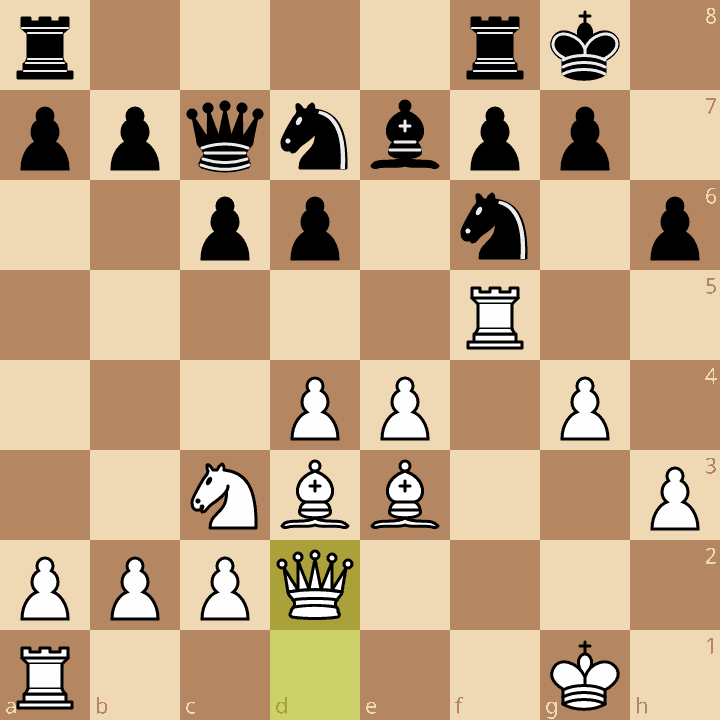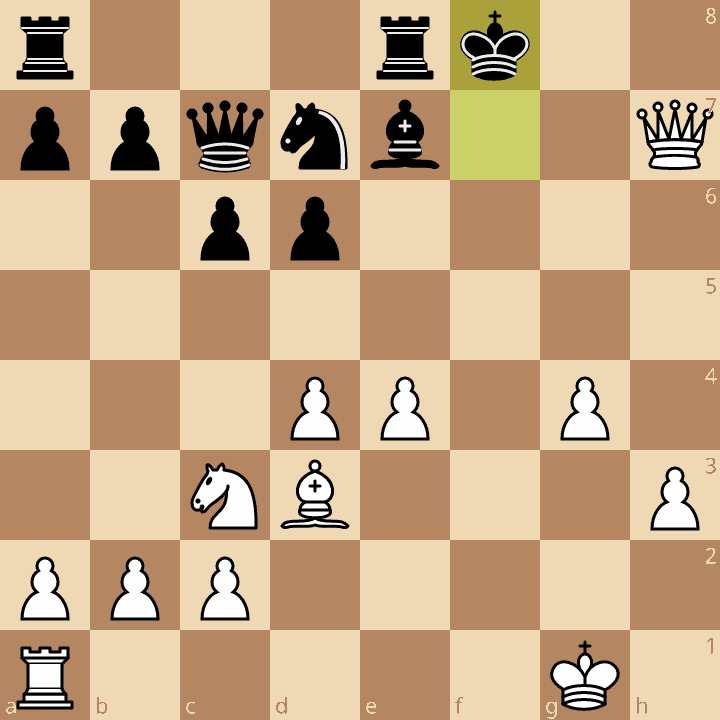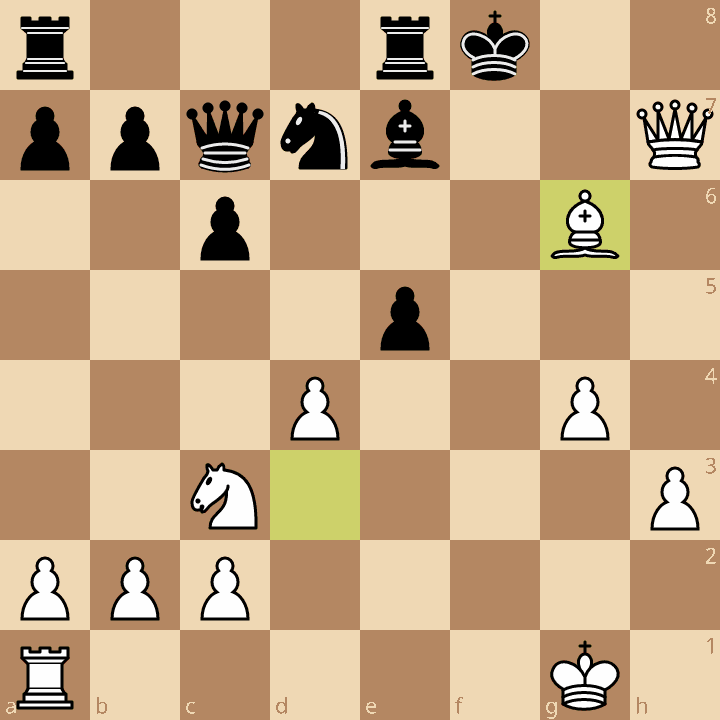Classical Game Recap: Piercing the Czech Pirc in a miniature
Evening the score against a historical rival.
Round 2 of the Spring Quads at Sacramento Chess Club. My next opponent is the highest rated player, standing at 1703. Hebert is the player against whom I have played the most USCF-rated games. My record against him across all formats is +3/-5/=4. In regular-rated games, it’s +2/-3/=3. I haven’t scored a win against him in almost two years, though in some cases I came very close, only to blunder them away. In our last regular-rated meeting, I lost to him with the White pieces. After doing a bit of research, and seeing that I was paired with him and had the White pieces for our game again, I decided to do just a bit of opening prep, and follow some advice I had received during a coaching session with IM Christof Silecki aka ChessExplained. Here’s how this game went.
Time Control: 60 minutes + 15 second increment per move.
White: Me (1651 USCF)
Black: Hebert Garcia (1703 USCF)
1.e4 d6
Hebert is an inveterate Sicilian Dragon player with a sharp tactical bite, and in our first tournament outing two years ago, I defeated him with the Yugoslav attack. Since then we’ve played many, many casual OTB blitz games, and we probably have an equal score. When he switched to the Pirc (“Peertz”) Defense, he let me know he plays it to dodge my prep against his Dragon. That, to me, signals at least a moral victory.
2.d4
When Black doesn’t prevent this move in 1.e4 openings, you might as well play it.
2…Nf6 3.Nc3 c6
This is known as the “Czech Pirc” or “Czech Defense”. In my experience what usually happens here is Black gets a Philidor structure without White being allowed to capture on e5 so easily, and from there Black can build their position, push on the queenside with b7-b5-b4, and generate some counterplay. This is one general idea of the Pirc Defense — to get a better Philidor.
4.f4!
Christof’s recommendation to me against any and all Pirc variations. Against the normal g6 Pirc, I still prefer the quiet line with 4.Nf3, but against 3…c6, I lost using 4.Nf3. That game continued: 4…Qa5 5.Bd3 e5 6.Bd2 Qc7 7.Qe2 Be7 8.h3 Nbd7 9.Nd1 (My main problem in this game was my discomfort with the lack of a castled King as a target, so I was trying to make clever waiting moves) O-O 10.O-O h6 11.Ne3 Re8 12.Nf5 Bf8 13.c3? Nb6? 14.dxe5? dxe5 15.N3h4?? (15.Ne3) g5! 16.Nf3 Bxf5 17.exf5 e4 18.Nxg5 (I am totally lost but trying to complicate the position as much as possible) exd3 19.Qxd3 hxg5 20.Bxg5 Bg7 21.Qf3 Nbd5 22.c4 Ne7 23.Bf4 Qc8 24.g4 Nh7 25.Rad1 Nxf5 26.gxf5 Qxf5 27.Kh2 Re4 28.Kg3 Rxf4 29.Qxf4 Be5 0-1 (GIF below)
4…Qa5
Indirectly attacking the e4 pawn, as its defender is now pinned.
5.Bd3 5…e5 6.Nf3 Bg4
7.O-O!?
I spent two minutes on this move. I was mostly seeing whether I could sacrifice the d4 pawn, and determined that I could. 7.Be3, holding the pawn and developing, is better, and is what Silecki recommends in his Keep It Simple: 1.e4 2.0.
7…Nbd7?!
Objectively, it’s best to win the pawn, either by Bxf3 followed by exd4, or exd4 right away. After 7…exd4 I planned 8.Ne2 c5 9.e5 dxe5 10.fxe5 with a lot of pressure in the center. After 10…Nfd7 11.Nf4 the position is really uncomfortable for black:
The e5 pawn is a bit poisonous. If 11…Nxe5 then 12.Qe1! (12.Re1? Nc6!) Qxe1 13.Rxe1 f6 14.Nxe5 fxe5 15.Rxe5 and Black’s position is difficult to extricate from.
If 7…Bxf3, then 8.Qxf3 exd4, and here Stockfish recommends quite a wallop with 9.Nb5! The point is that after 9…cxb5, 10.e5 wins back the piece and then some. The prosaic 9.Ne2 would also be fine due to the continual threat of 10.e5 followed by 11.Qxb7
8.Be3 Be7 9.h3
Transposing back to Silecki’s recommended line. My opponent feels compelled to give up the bishop pair.
9…Bxf3
10.Rxf3!?
This is an idea in a similar line in Silecki’s Keep It Simple 1.e4 2.0: 9…Bh5 10.Qe1, where Silecki remarks: “Stockfish suggests 10…Bxf3 is the only(!) playable move, but White still has a large advantage after Rxf3, of course.”
Here according to Stockfish, 10.Qxf3 is better, but I liked the idea of using the semi-open f-file with the rook, and the complications arising could possibly gain me some time as my opponent had to figure out how to deal with those coming threats.
10…O-O
11.g4!?
I spent three minutes on this move. I decided to go for a caveman attack, with g4-g5 (or h4-Rg3, then g5), because Black’s kingside situation already looked a bit problematic. Better was 11.Kh1. Stockfish wants to take space on the queenside first with a4-a5 before going for a kingside attack.
11…exf4?!
My opponent felt a lot of difficulty in this position, such that he spent 15(!) minutes on this move. This opening of the f-file plays right into my plans. 11…exd4 was a bit better. I think the main merit of this move is that it weakens the g1-h7 diagonal, and can give black some counterplay, or at least keep the dark square bishop busy defending that weakness.
12.Rxf4!
Another three minutes spent, but clearly the bishop should stay on e3 to cover the weakness on d4, for now.
12…h6 13.Rf5! Qc7
Eyeing g3 should the diagonal open up. I think that overall, 13…Qb6 is stronger. It slows White’s attack (due to the potential Qxd4+ should White move the e3-bishop). I planned 14.Kh1 or even 14.Kg2.
14.Qd2!
Now I’ve noticed that this particular h6 pawn is very weak. I had initially planned on pushing g5, but Qd2 was more compelling: The a-rook is ready to slide to f1 where I dominate the semi-open f-file.
14…Rfe8
My opponent spent 17 minutes on this move. I think he saw the coming sacrifice, and was trying to make room for his pieces. For instance, a plausible idea was to move the Bishop to f8 to defend the g7 square in the case of an attack. This fails due to the rook on the fifth rank. While my opponent pondered his choices, I was able to think a lot about my own responses to his possible moves. I wondered a lot about 14…g6 in this position:
15.Bxh6 Nh7 (15…gxf5?? 16.Qe5+ with mate to follow) 16.Rf2. Of course I could also respond with 15.Rf2!? immediately and still be in good shape, since the h6 pawn is hanging. Both of these were viable. At the time, I was more inclined toward 15.Rf2 which superficially felt safer.
I also considered 14…Nh7 15.Bxh6 gxh6?! (Black should refuse and play 15…Rd8, 15…Qd8 (I planned 16.e5) or 15…g6, but that transposes to the other line) 16.Qxh6. In any case, my opponent gave me so much time to think about the possibilities that my excitement grew the longer he spent stewing over it.
15.Bxh6!!
I spent 13 minutes here. Mostly, I was trying to figure out whether or not I should play 15.e5 first in order to open up the d3 bishop against h7 (This was my original target before I realized that g7 is indefensible due to the rook on the fifth rank); however, 15.e5?? dxe5! and 16.Bxh6 is impossible due to 16…exd4! and White must move the knight (17.Ne2) to prevent a disastrous attack on the open king wherein White loses a piece, allowing Black to successfully defend g7 with 17…Bf8. My other option, that was probably just as strong as the sacrifice, was 15.Raf1, where the position is stably in White’s favor, but as one practical downside it also gives Black another chance to organize the defense and complicate matters. Ultimately, I realized that I had no reason to give Black counterplay, and thus decided to bite the bullet on this sacrifice, because it’s so forcing and leaves the king stripped of all defenders.
15…gxh6??
A fatally compliant response. My opponent appeared resigned to it, but Black could put up more resistance with 15…Bf8. 16.Be3 or 16.Bg5 would be good follow-ups. White is still winning, and (after 16.Be3,) g5 is coming with vengeance, but Black would make the win harder to find.
16.Qxh6
16…Nh7?
16…Nf8 provides a lot more resistance by covering h7 again. Against this, during my calculations of 15.Bxh6 gxh6 16.Qxh6 Nf8, I looked at the following ideas:
17.Rxf6?! Bxf6 18.Qxf6 - This essentially wins two pawns and a rook for knight and bishop. After 18…Re6, Black gets a lot of counterplay. Materially this should be fine for White, but it’s not nearly that strong. I rejected this line pretty quickly.
17.Raf1 - Similar to 15.Raf1, it leaves White in a winning position, but because this move doesn’t come with any tempo, maybe Black could organize a defense after 17…Ng6, which was an annoying occurrence in many lines I calcualted.
17.Rg5+ - After 17…Ng6 18.Rxg6+! fxg6 19.Qxg6 Kh8 20.e5! and Black is mated soon, but this wasn’t as clear to me at the time — I figured the sacrifice on g6 was strong, but I thought I had better.
17.e5! - 17…Ng6 18.Rxf6! (18.exf6 Bf8 — the attack rages on but it’s harder to find the path forward) Bf8 19.Qh5.White’s about to chop on g6 with the bishop, and the king will not be able to escape.
17.Rxf7!!
A second sacrifice, one that I spent seven minutes. I considered this move after 16…Nh7 back when I was calculating 15.Bxh6, but now with it in front of me I wanted to make sure it was absolutely correct, since there’s no coming back from a double piece sacrifice if it fails, and I’ve been burned more than once. At the very least, I knew I had a draw in hand via repetition (see below notes) if I failed to find the winning position, so I went for it.
17…Kxf7 18.Qxh7+ Kf8
The only move.
18…Ke6?? 19.Qf5#
18…Kf6?? 19.Rf1+ Kg5 20.Rf5#
19.e5!
Finally, this is the right time to open the diagonals for the bishop. Black has no time for counterplay, and the Black king is trapped with no more squares. Another alternative was 19.Rf1+, but then Black can prolong resistance on the f6 square.
19…dxe5?
Unnecessarily non-resistant though in this position, Black is dead to rights. I saw:
19…Nf6 20.exf6 Bxf6 21.Qxc7 — the undefended queen!
19…Rc8 (defending the queen) but then 20.Bg6 would end all resistance anyway.
20.Bg6 1-0
Black resigned. It’s 21.Qf7# the next move.
Takeaways:
I didn’t make any real mistakes this game, just a few inaccuracies that could have complicated the game. However… My opponent fell into virtually my every plan. When you’re faced with a difficult position, don’t do this. Create an active plan instead, and try to insist on your own counterplay and plans and disrupt your opponent’s ideas as much as possible!
When you sense the critical moment, use every minute you need to make sure you’re doing the right thing. On the two sacrifices I spent 20 minutes. On 10% of the moves I played, I spent 33% of my allotted time. It was worth every second!
Game in a GIF:
















Studying all that romantic chess is paying off! Nice one Nick